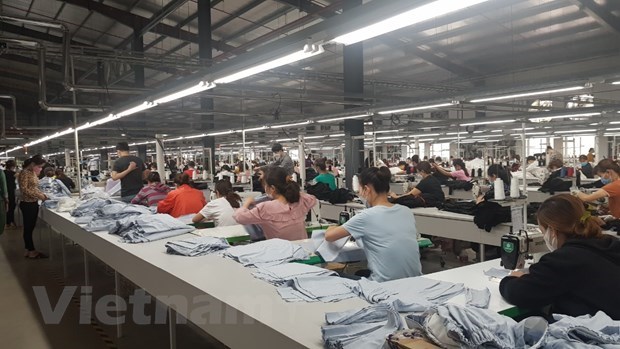WB forecasts Vietnam's GDP growth to lead Asia in 2022
The World Bank (WB) has forecast Vietnam's economy to grow by 7.2% in 2022, the highest growth rate among East Asian and Pacific economies.
 A garment factory in Vietnam (Photo: VNA)
A garment factory in Vietnam (Photo: VNA)According to the East Asia and the Pacific (EAP) Economic Update October 2022, released on September 27, WB experts said the growth will be supported by a strong recovery in domestic demand and continued solid performance by export-oriented manufacturing. However, it would revert to standard rates over the medium term, with 6.7% for 2023 and 6.5% for 2024.
The economy rebounded strongly from COVID-19-related lockdowns in the third quarter of 2021, expanding by 6.4% in the first half of 2022, the report said.
The WB attributed the rebound to a recovery of exports and the release of pent-up demand following the removal of COVID-19-related restrictions and, more recently, the gradual return of foreign tourists.
The services sector grew by 6.6% during the year's first half, including a record-high growth of 8.6% in the second quarter. Indeed, industrial production, excluding construction, grew by 8.4% in the first half, fueled by resilient external demand.
Inflation inched up to 3.1% year on year in July, primarily driven by higher transport costs which increased by 15.2%, despite efforts made by the authorities to contain price pressure through cuts in fuel excises.
In the medium to long term, the bank said that achieving Vietnam's goal to become an upper-middle income economy will depend on transitioning to productivity and innovation-led growth model based on more efficient use of productive, human, and natural capital.
Like other East Asia and Pacific (EAP) countries outside China, the Vietnamese economy is projected to rebound in the year ahead with growth of 7.2%, driven largely by low base effects after the lockdown-induced contraction last year, before subsequently reverting to trend growth over the medium term.
Growth drivers are anticipated to pivot from external to domestic demand, with manufacturing and services exports to major markets, including the US, the EU, and China. Therefore, inflation is projected to accelerate to 3.8% in the year ahead and 4% in 2023 due to the second-round effects of commodity price impacts before subsiding to 3.3% in 2024.
Public expenditure is expected to accelerate in the year's second half, with the fiscal deficit reaching 2.8% of GDP, providing some support to the economy. However, the deficit is projected to rise slightly to 3.2% of GDP as the 2022 - 2023 support programme is implemented.
After a period of stagnation during the COVID-19 crisis, the pace of poverty reduction is expected to pick up, with the poverty rate declining from 3.7% in 2021 to 3.3% in 2022, based on the World Bank's Low and Low Middle-Income Countries (LMIC) poverty line.
Given Vietnam's ongoing economic recovery and well-controlled inflation, the current accommodative monetary policy remains appropriate in the short term. In contrast, a more supportive fiscal policy would hedge against downside risks, including heightened financial risks.
However, Vietnamese authorities should consider recalibrating monetary and fiscal policies if inflation overshoots 4.0% and core inflation hikes up.
Notably, higher financial sector risks would require intensified prudential supervision, reporting and provisioning on NPLs, and improved corporate insolvency and banking sector resolution frameworks.
On the regional scale, three factors could hinder regional growth beyond 2022: global deceleration, rising debt and policy distortions. As a result, the growth is projected to slow to 3.2% this year and accelerate to 4.6% in 2023.
Potential output in the region is now projected to expand 4.6% year-on-year over the 2022-2030 period, down from 6.5% in the decade preceding the pandemic.
The consumer price index has risen recently but remained around target ranges in several major economies. Meanwhile, inflationary pressure is building rapidly in other countries, reflecting mounting energy and food prices and distinctive factors.
In most EAP countries, the rise in public debt during the pandemic was driven primarily by increased domestic debt. At the same time, private sector debt remains high, especially household debt in China, Malaysia and Thailand.
Poverty in the region is expected to fall thanks to continued recovery from the pandemic. As a result, the pace of poverty reduction returned to pre-pandemic levels in 2022, and the number of poor is projected to reach historic lows./.













